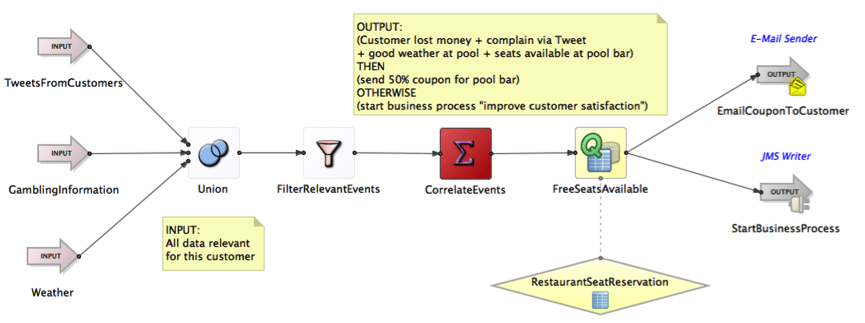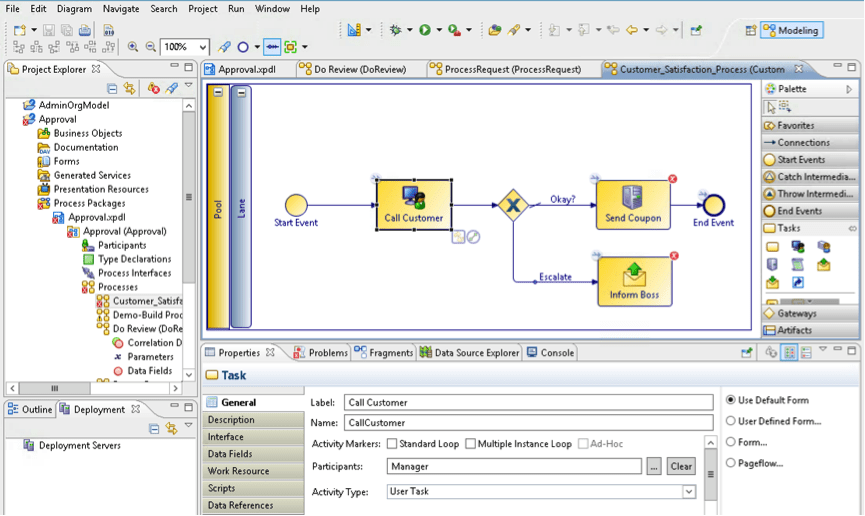Today, humans have to interpret large sets of different data to make a decision. Using your gut feeling is nothing but gambling. Therefore, Big Data analytics is getting more and more important every year to make better decisions. However, just doing Big Data analytics is not enough. In many use cases, systematic and monitored human interactions are as important to get best outcomes.
Making the data “actionable” is the real challenge! Seeing the information that helps to make a decision on a composite dashboard using business intelligence (BI) and Big Data analytics is just the first step and where too many companies stop. An enterprise must be able to fire off the business process to execute the decision made regarding the data. That’s where the buzzword “Intelligent Business Process Management Suite (iBPMS)” comes into play.
iBPMS = BPM + Big Data/Fast Data Analytics + Social Integration
iBPMS is a term introduced by Gartner to indicate the evolution of the classic BPMS into the next-generation of BPM, which includes integration of Big Data analytics, social media, and mobile devices into organization’s business processes support.
Some other companies and analysts use different names, for example “Operational Business Process” or “Intelligent Business Operation (IBO).” Many people also abbreviate this topic with iBPM instead of iBPMS. However, in the end, everybody is talking about intelligent business processes.
An intelligent business process combines Big Data, analytics, and business process management (BPM)—including case management! This enables applications and humans to make data-driven decisions based on Big Data analytics. Two flavors exist: “Process starts Big Data analytics” (e.g. a recommendation engine) and “Big Data analytics starts process” (e.g. prevention of the flu epidemic or predictive fault management).
Let’s look at a real-world use case to show why realizing intelligent business processes makes a lot of sense, and how to actually build such a solution.
Use Case: Improved Customer Relationship Management (CRM)
A casino wants to increase customer satisfaction. Therefore, the casino leverages Big Data analytics and gives customers a digital identity (including hotel preferences, gambling behavior, etc.), so that customers can get personalized offers in real time. For instance, the casino can offer a 30% coupon for a show ticket (which is not sold out yet) or a free steak tonight (which would be perishable tomorrow anyway, not to mention there are many empty seats currently in the restaurant). Besides increasing customer satisfaction, the casino creates further benefits such as cost reduction or increased revenue. For instance, a customer visiting a show or eating a steak will also spend money for drinks.
TIBCO Products to Implement an Intelligent Business Process
The following implementation uses different TIBCO products to realize the use case. Even if you have never seen these products before, you will understand easily how these tools work together to realize an intelligent business process.
All these products are loosely coupled, but tightly integrated. Each TIBCO product has a specific task to solve. Nevertheless, they connect to each other very well via specific adapters or standards for interoperability—such as SOAP/REST Web Services or JMS messaging—if you have to integrate with non-TIBCO products.
Let’s discuss the five steps that are necessary to realize the described use case.
Step 1: Integration of Siebel CRM, ERP Data stored in Hadoop, and CICS Mainframe Payment Data with TIBCO BusinessWorks
Integration of different systems and interfaces is the first step. Complex transformations have to be realized to format and process all required information correctly. TIBCO BusinessWorks is used as an integration and service delivery platform, often also called Enterprise Service Bus (ESB).
Tasks:
- Integrate customer data from Siebel CRM.
- Integrate casino data from ERP stored in Apache Hadoop.
- Integrate payment information from CICS mainframe via REST interface.
- Process incoming gambling information from slot machines via EDI.
- Push transformed streaming events in real time to output connector.
Step 2: Real-Time Streaming Analytics with TIBCO StreamBase
The pre-processed data is pushed into a stream processing engine for real-time streaming analytics. TIBCO StreamBase is a mature product with awesome tooling for these tasks.
Tasks:
- Filter and analyze all kinds of events.
- Correlate relevant events.
- If possible, act in real time automatically.
- Otherwise, start a business process for human interaction.
For example, you correlate events such as “customer lost a lot of money playing on a slot machine,” “complaint via Twitter,” “good weather,” and “seats available at pool bar” to send a 50% coupon for a cocktail at the pool bar. If no free seats are available at the pool bar, a human has to make a decision how to improve customer satisfaction. If a customer complains about his current situation, another more complex business process has to be initiated using flexible case management features of the BPM tool.
Step 3: Automatic Reaction or Human Interaction with TIBCO ActiveMatrix BPM
If a task cannot be automated completely, a business process instance is started to react appropriately to an event. This can be a relative simple process with human interaction and automated steps, or a more complex situation requiring flexible case management. TIBCO ActiveMatrix BPM is the right tool for this job. The current release already includes several case management features!
Tasks:
- Do something to make customer happy again, e.g. check if the steak restaurant has plenty steaks in stock. Call customer on his mobile phone and offer a steak dinner. Alternatively, you could even let the waiter bring the coupon to the slot machine if you use geolocation features.
- Send dinner coupon via SMS or email.
- Or escalate to your manager if the customer does not appreciate the offer. Case management features can be used here to enable humans to act in a more flexible way to unexpected events.
Step 4: Work Distribution to Mobile Apps with TIBCO eFTL Mobile
Work distribution to mobile devices (smartphones, tablets, watches) with TIBCO eFTL Mobile process notifications are used for work distribution to occasional users. These can interact via their iPhone, Android smartphone apps or other mobile clients such as Apple’s iWatch.
Different alternatives exist to integrate the communication with mobile devices. For example, TIBCO eFTL provides full-duplex, bidirectional communications to web and mobile users by using HTML5 and WebSockets under the hood.
In the above example, the manager would receive a push message about the escalation on his iPhone while walking around in the casino. He can react immediately by sending a message to a colleague or starting another business process via its mobile BPM app.
Step 5: TIBCO BPM Analytics—A Picture is Worth a Thousand Processes
After the implementation is deployed and running, you can investigate and improve your intelligent processes by using explorative data analytics. TIBCO BPM analytics provides end-to-end process visibility including self-service, interactive, drag-and-drop reports for business users. TIBCO Spotfire—a business intelligence tool for explorative data analytics—is integrated into TIBCO ActiveMatrix BPM (and many other TIBCO products) for that reason.
The Realization of Intelligent Business Processes (iBPMS) Is No Rocket Science
The above sections showed an implementation of an intelligent business process using TIBCO’s iBPMS tooling. A BPM solution is not the only thing you need to realize intelligent business processes. You need to integrate different enterprise applications and Big Data/Fast Data analytics. Integration and separation of concerns is key for success of such a project. iBPMS sounds like a very complex topic first. However, it is easy to implement iBPMS if you can use loosely coupled, but tighly integrated tooling to solve your requirements.
Next step for you is to think about iBPMS opportunities in your projects. Get started by downloading TIBCO Business Studio Community Edition or taking a look at more detailed slides about this topic: “Intelligent Business Process Management Suites (iBPMS) – The Next-Generation BPM for a Big Data World.”









